What makes our products sustainable
Produced with low emissions, ecologically conscious material selection, energy-saving and water-saving usage – products for cleaning and care should be sustainable in many ways. Therefore, responsible behaviour at Kärcher includes machine development and the production and supply chain right up to correct disposal – and so does not end at our factory gates.
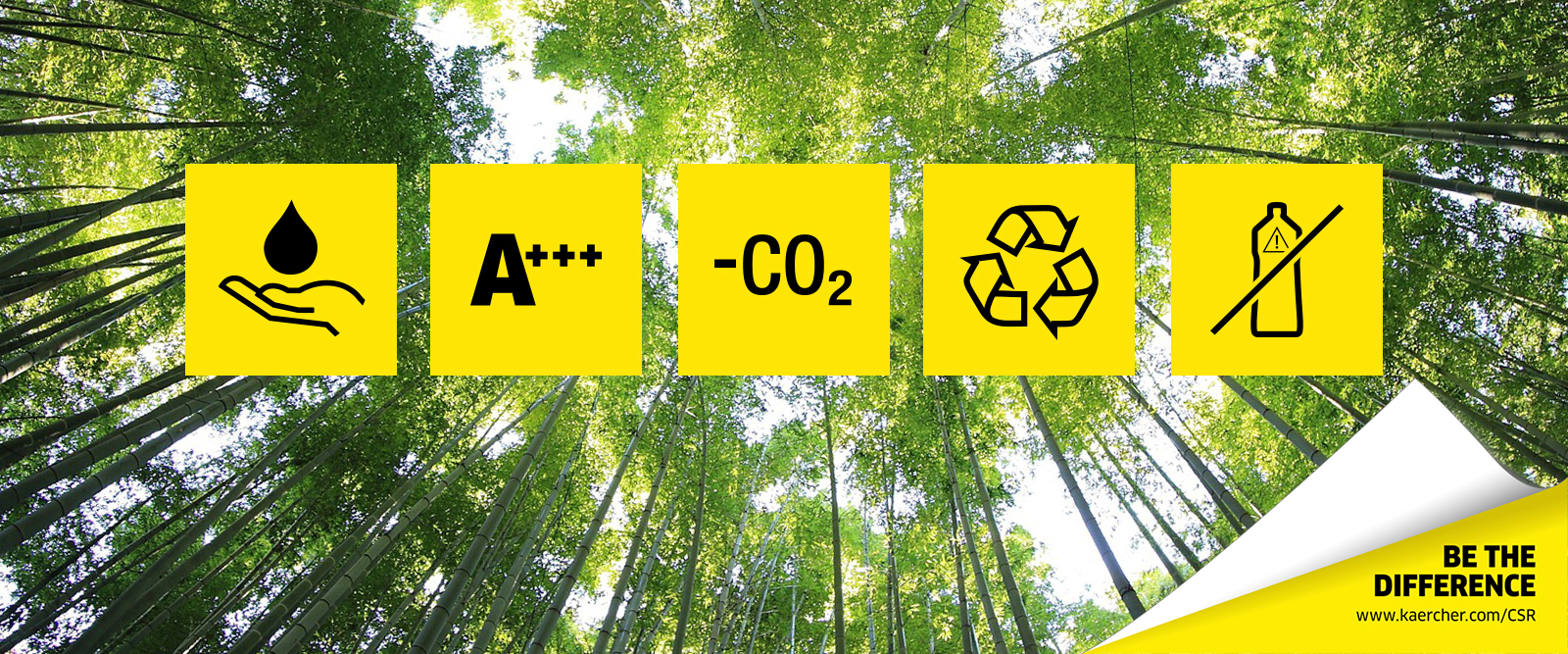
Contribution to value preservation and durability
Consumers now ask important questions upon purchase: Where was the product manufactured, by whom and in what conditions? What materials is it made of? And can it be recycled afterwards? How efficiently does the machine operate? We take these concerns very seriously. Kärcher offers cleaning solutions for households, industry and business – and these consume water, electricity and cleaning agents. But Kärcher technology also contributes significantly to value preservation and the durability of buildings or machines – and there is already a great deal of sustainability in this.
Learn more here about the sustainability aspects of high-pressure cleaners, vacuum cleaners and co.

Saving water
Handling the resource of water responsibly is now more important than ever. What our technology can contribute to this? Cleaning machines can ensure that less water is consumed in a number of ways. Recycling systems in gantry car washes, for example, collect up to 98 per cent of the used water, process it and use it for the next cleaning process. High-pressure cleaners save around 80 per cent of water due to their high cleaning performance compared to working with a garden hose. Pumps for the garden make rainwater usable for watering the area around the house. These examples provide an impression:
Even after emptying, contaminants can remain in a scrubber dryer's dirty water tank, accumulating and starting to cause unpleasant odours. That's why operators rinse the tanks after use. They usually do this by spraying the tank walls with a hose. This requires a lot of water, and causes spills of residual cleaning agent and dirt deposits. Kärcher has developed automatic closed-lid tank rinsing to avoid this – with the key word being contactless cleaning. Operators simply connect the hose and ten nozzles distribute the water inside the tank to remove any remaining residue. The water drains in a controlled way without splashing. But most importantly, the nozzles can work with very little water. Day-to-day, they use 70% less water than conventional hose rinsing.

The B 110 R ride-on scrubber dryer cleans large floor areas, for example in shopping centres or car parks, using very little water. How does it do it? The new eco!Flow mode adapts the water flow rate to the driving speed. This means that the machine uses more water when driven at high speed. When travelling slowly, for example on corners, it requires much less water to clean thoroughly. eco!Flow mode detects the driving speed and adjusts the water volume accordingly. Cleaning therefore always takes place with a constant water volume per square metre and significant overdosing when driving slowly can be avoided. This enables water savings of up to 50% compared to machines with constant water delivery.
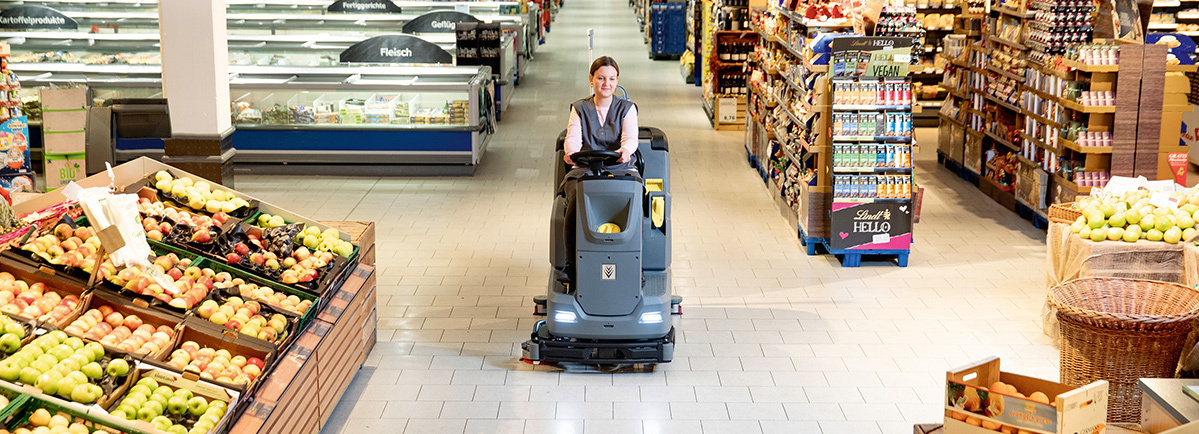
The WRB 4000 Bio water treatment system for biological waste water purification treats the waste water from vehicle wash systems in a natural and environmentally friendly way. The system by our partner Aquadetox can process up to 4,000 litres of water an hour, thereby returning up to 98 per cent as clear and odour-neutral reclaim water into the circuit or directing 100 percent into the sewer system in compliance with the legal provisions. In doing so, it removes cleaning agents and drying aids reliably and without the use of flocculation agents and other chemicals.
Reliable recycling of the water is done in four steps: Firstly, undissolved floating materials and coarse solids are captured and deposited in the sludge trap. In the next basin there are micro-organisms that almost completely metabolise and remove the dissolved organic substances, e.g. oils, fats or surfactants, from the water. In the third step, the water goes to the above-ground post-sedimentation stage, in which residues like loosened excess sludge are filtered out. The recycled water is finally collected in a tank and the next washes fed back.

Strongly contoured vehicles, demanding customers: The requirements of vehicle wash systems are becoming ever greater. If oil companies, service stations or car dealers want to offer their customers a premium service even at a high washing volume, powerful systems are required. Water is self-evidently saved with the CWB 3 Klean!Star iQ gantry car wash. Thanks to the standard water saving function, only 20 litres of fresh water is required for a vehicle wash. This conserves natural resources and reduces operating costs.

Kärcher high-pressure cleaners save up to 3,100 litres an hour, meaning they use about 80 per cent less water compared to cleaning with a water hose. They are distinguished by a great cleaning performance and cleaning efficiency with inherently lower consumption, which makes cleaning expeditious – consequently saving time, water and energy.
This is due to patented nozzle technology and customised adaptation to the performance of individual machines – you get a better result faster. In addition, most models can also be operated with reclaim water. For this, the machines simply suck the water from an available reservoir – for example from a water butt. This way, the user dispenses with the use of drinking water, thereby protecting the environment, and is also independent of the water supply.

Booster pumps enable the easy supply of the house and garden with well water or rainwater, e.g. with the BP Garden. The BP Home & Garden electronic booster pumps pump reclaim water automatically through the whole house. The BP Barrel barrel pump, the BP Cistern cistern pump and the BP Deep Well deep well pump work directly in the water.
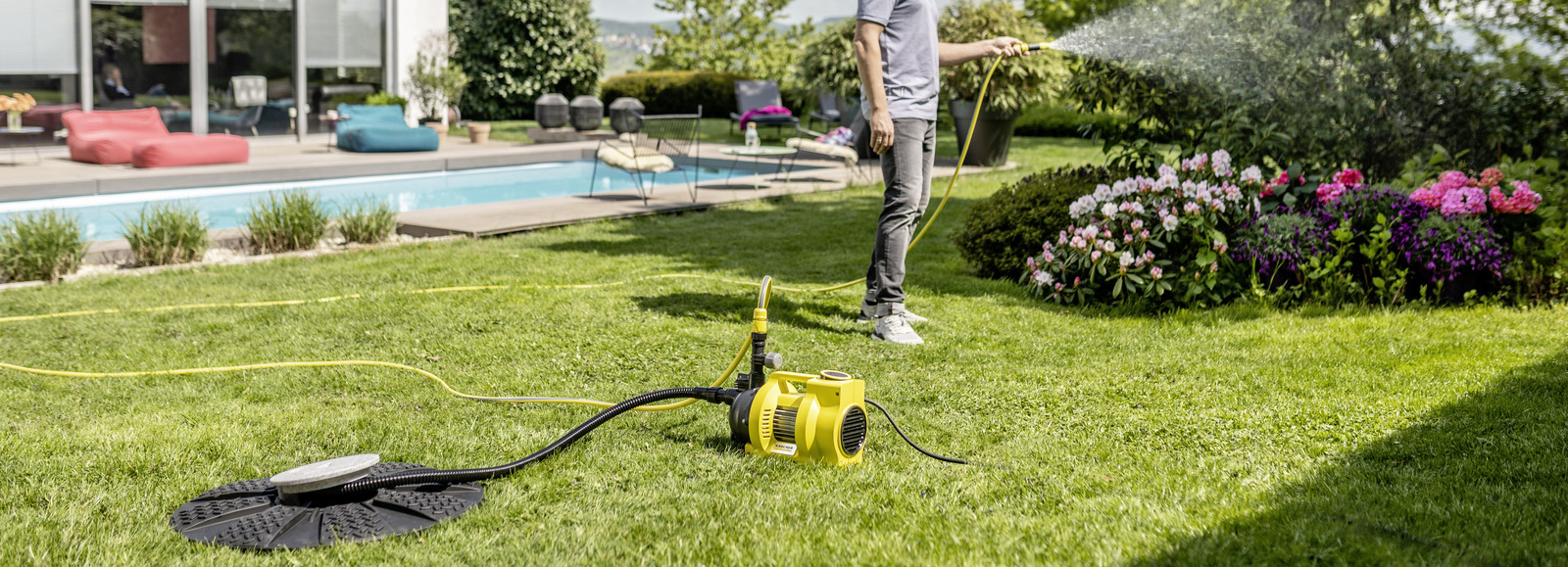
The FC 7 Cordless floor cleaner removes all types of dry and wet daily contamination in a single step. There is therefore no need to vacuum before wiping the floor. This saves the machine up to 90 per cent of water when cleaning a 60 m² floor area, in comparison with a conventional mop with bucket.
The FC 7 Cordless works with four contrarotating cleaning rollers that are continuously moistened with fresh water and cleaning agent. The rollers reliably pick up all types of household dirt and wipe the floor both in the forward and reverse movement.


Using energy efficiently
We are constantly improving the energy efficiency of our products – no matter whether they are corded, supplied by a battery or supplied by a combustion engine. An important development in terms of cleaning machines is the Kärcher eco!efficiency mode, which can also be activated during operation. With it, the machine functions are automatically managed at the best possible efficiency. This reduces the consumption of energy, water and cleaning agent. These examples show how that works in practice:
Lithium-ion batteries are significantly more sustainable than old lead acid batteries. That's why Kärcher has been using modern batteries in its compact machines for a long time, and is now extending this strategy to its larger models, including walk-behind and ride-on scrubber dryers. This is primarily because, at around 3800 charging cycles, the lifetime of a lithium-ion battery is up to four times longer than that offered by the previously used lead acid batteries. Or, to be precise, even more than that, since usage and charging errors that can damage and reduce the lifetime of lead acid batteries are not possible with lithium-ion batteries. A machine's durability is a major factor in its sustainability. Lithium batteries pay off for customers too – as soon as the battery is swapped over for the first time, the additional cost of a lithium battery is paid off compared to maintenance-free gel or AGM batteries.
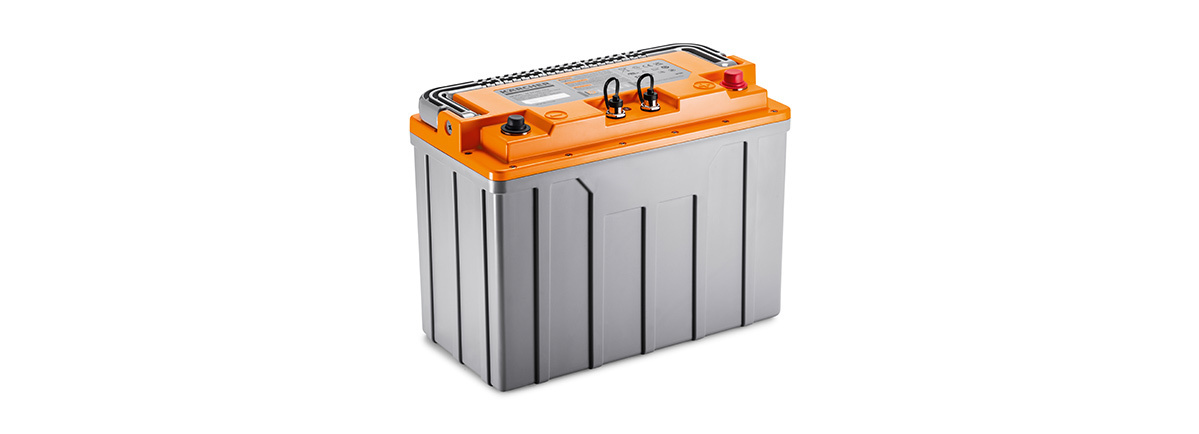
Numerous model series of Kärcher scrubber driers already have an eco!efficiency mode. With it, the brush speed and the suction power are reduced to a performance sufficient for lighter dirt. This allows convincing cleaning results with significantly lower consumption to be achieved. Up to 30 per cent of energy and 10 per cent of water and cleaning agent can currently be saved with the eco!efficiency mode.

With hot water under high pressure, comparable cleaning results are achieved with a significantly decreased use of water. Moreover, the eco!efficiency mode is used with hot water high-pressure cleaners. If it is active, the water temperature is set to 60 °C, as this temperature is completely sufficient for most cleaning tasks. The burners of the hot water high-pressure cleaners are especially efficient and environmentally friendly, as confirmed by the EUnited Cleaning association. Kärcher was the first manufacturer of cleaning equipment in the world to receive such a certification.
The certification includes several elements: The burners used must display an especially high effectiveness, while at the same time not allowing emissions of soot and carbon monoxide to exceed the very low limits. This combination leads to particularly environmentally friendly machines that not only release few harmful substances, but simultaneously make operating costs low due to their low consumption. The industry association EUnited Cleaning is the leading provider of floor cleaning machines and high-pressure cleaners for professional use.

With 40 per cent lower power input, the eco!efficiency dry vacuum cleaners achieve 98 per cent of the suction power of the basic machine, which is more than sufficient for daily maintenance cleaning. At the same time, the suction of eco!efficiency machines is nice and quiet, and can be measured and felt at only half the volume. With cordless machines, it also extends the working life while simultaneously offering a strong cleaning performance.

Kärcher water dispensers significantly reduce the energy expenditure for the provision of filtered, cooled or carbonated water compared with conventional drinking solutions. The standby mode of the advanced machines allows the operating time of every Kärcher water dispenser to be individually adjusted, so that the machine is only operated with minimum energy (< 0.5 watts) on days it is not used, for instance at the weekend. Upon request, ECO mode can also be activated. In this mode, water dispensers heat up water, for example, bit by bit just at the press of a button and do not keep it permanently hot. Cold water becomes less cool if not used for a very long time, with less energy likewise being consumed for provisioning. Energy consumption is reduced in this way.
In addition, grid-bound water dispensers significantly reduce CO₂ emissions, as the water is not transported laboriously for many kilometres in a lorry. In standard application, the Kärcher WPD models release about 80 per cent less carbon dioxide compared with gallon systems. Compared with bottled water, it is even about 90 per cent less. A further advantage compared with bottled water is potentially dispensing with disposable plastic bottles.

The Kärcher Battery Power exchangeable battery of the 18 or 36 V battery platform is suitable for use in numerous machines. Thanks to Real Time Technology and LC display, the remaining life, remaining charging time and charging state – depending on the machine used – are always on display.
In the home environment, battery-powered machines are not in use daily. For example, garden tools are practically never used in winter. Storage mode guarantees a long cell lifetime if they are lying unused in the garage over a longer period. A charging state of 70 per cent is ideal for longer storage. If the battery pack is stored at over 70 per cent and not used for more than 21 days, a mode is automatically activated that partially discharges it to 70 per cent.

In car washing, in addition to the cleaning result, the sustainable and responsible operation of a facility plays an important role for both customers and operators. The aim is to conserve resources in the use of water, energy and cleaning agents. The use of dry foam instead of wet foam in Kärcher SB MB / SB MU self-service washing systems makes it possible to use up to 90 percent less water and chemicals and save up to 75 percent energy. Each operator can also decide for himself whether the wash programmes are operated with hot or cold water. If cold water is used, using the example of a system with 4 washing stations, this means an energy-saving potential of at least 55 percent. The powerful pumps also ensure energy-efficient operation.


Reducing emissions
Especially in interior spaces and if users work directly on the machine, it is important to reduce emissions or totally avoid them where possible – including operating noise. So it is particularly important with vacuum cleaners, for instance, that they really capture the drawn-in dust and do not release it from the machine again. In other areas, such as with lawn mowers and electric saws, the switch from machines with a combustion engine to electrically operated machines can ensure that absolutely no more direct emissions are produced. Kärcher counts on efficient filter systems for products or offers emission-free products such as the machines of the battery platforms.
Kärcher's professional cleaning agents are also available in concentrated and even highly concentrated form, which means a lot of active ingredient per bottle and canister! Users simply dilute the cleaning agents with water on site. This saves a considerable amount of packaging material, as the contents of the bottles and canisters are significantly more efficient. The cleaning agents for our high pressure cleaners are even doubly diluted. Firstly by 25% on filling, then the machine dilutes the cleaning agent again in order to achieve the best possible results with minimum consumption. Transport distances are also reduced by the high concentrates since customers can afford to re-order much less often than with pre-diluted cleaning agents. The concentrates also improve the carbon footprint for transport, since only the active substance is transported, without water.

The best type of emissions are those that are never produced. That's why Kärcher is offering more and more machines with modern battery technology, for example leaf blowers, lawn mowers, chainsaws, lawn trimmers and hedge trimmers. The batteries are available in two volt classes: 18-volt batteries for compact and easy-to-use machines and 36-volt batteries for particularly powerful machines. These batteries can be used in all machines within the same voltage class. In addition, they are particularly durable as efficient temperature management protects the batteries from overheating and being overloaded when the going gets tough. And if a machine is out of operation for a long time, the battery automatically switches to protective storage mode. Another advantage alongside working without emissions is that the machines are quiet and do not pollute the environment with engine noise.
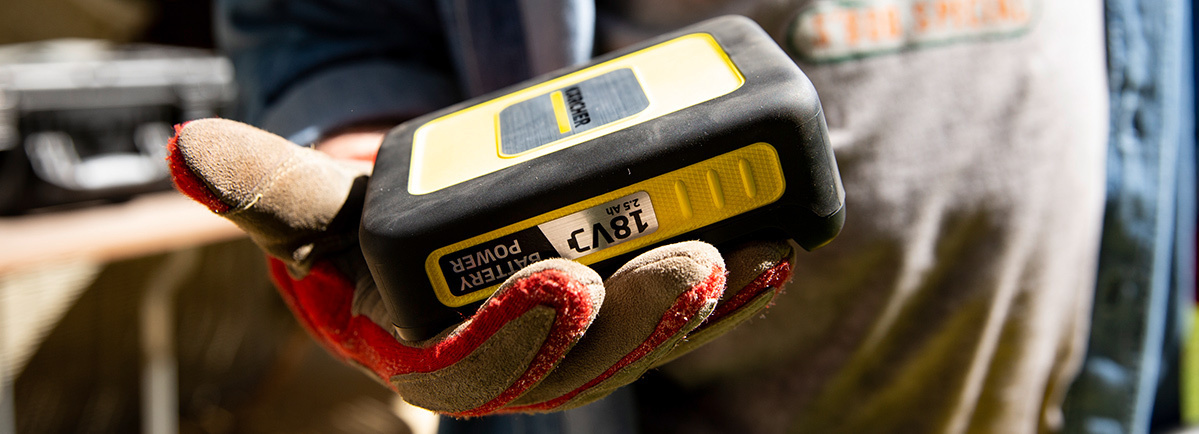
Many tasks on construction sites, in workshops or on the production line for industry produce large amounts of dust. Various precautions must be taken in order to comply with work protection regulations and keep the impact on health as low as possible. The aim is to keep work environments largely dust-free. Types of dust that also contain constituents such as pollen, quartz, mould, viruses or even asbestos are especially problematic.
Safety vacuum cleaners are designed so that they reliably absorb and dispose of such particles. Filters are designed to collect fine dust particles and prevent them from being released back into the surrounding air. When dealing with large amounts of dust, there is a risk of this clogging up the filter and considerably reducing the suction power. Safety vacuum cleaners are therefore equipped with systems for filter cleaning.
Fully automated functions for filter cleaning allow the absorption of large quantities of fine dust without interrupting work or losing suction power. Kärcher also uses the further developed Tact system in its safety vacuum cleaners. Here, a sudden switch of the air flow cleans the filter automatically.
HEPA 14 filters in air filtration devices and vacuum cleaners are effective and reliable in removing viruses, bacteria, fungi and germs. As a market leader in innovative cleaning solutions, Kärcher has succeeded in combining the superior filter qualities of HEPA 14 filters (DIN EN 1822:2019) with high-performance products, thereby making a substantial contribution towards greater safety in enclosed rooms.

Noise emissions too are emissions that should be reduced. Therefore, we optimise our machines both in terms of their volume and the type of noise. The K 2 Silent high-pressure cleaner is 10 dB(A) quieter than the previous model. A person will perceive this reduction as a halving of the volume. In addition, the frequency spectrum has been influenced so that the remaining noise is felt as significantly more pleasant. We have achieved this by using innovative plastics, such as special polyurethane damping materials. These effectively disconnect the pump from the housing. In addition, we use sound-absorbing foam mats made of melamine resin.


Responsible use of plastic
Since 2012, we have managed to quadruple the amount of recycled plastic in our machines. In material procurement, we watch out for sustainable resources, allowing us to close the circuit and to reuse the recycled plastic in products. We have made it our goal to achieve a recycled plastic content of up to 50 per cent in the Home & Garden high-pressure cleaners by 2025. How sustainable material use already looks today:
The use of plastic cannot be entirely avoided, for example, in the manufacture of containers for cleaning agents. This is exactly why it is important to Kärcher to find solutions that protect our resources: The canisters and bottles should be as lightweight as possible for low-emission transportation and be made from recyclable plastic. Kärcher also aims to use a high proportion of post-consumer recycled materials, i.e. plastics that have already been recycled, for its containers. The sounds easier than it is, as the containers need to pass resistance tests to show that they will not be damaged, for example in the event of a fall or impact, during transport and loading. Even though recycled plastics are unfortunately less robust, Kärcher has still managed to increase the amount used to 50%, for example in the cleaning agent accessories kit for the BR 30/1 push scrubber dryer.
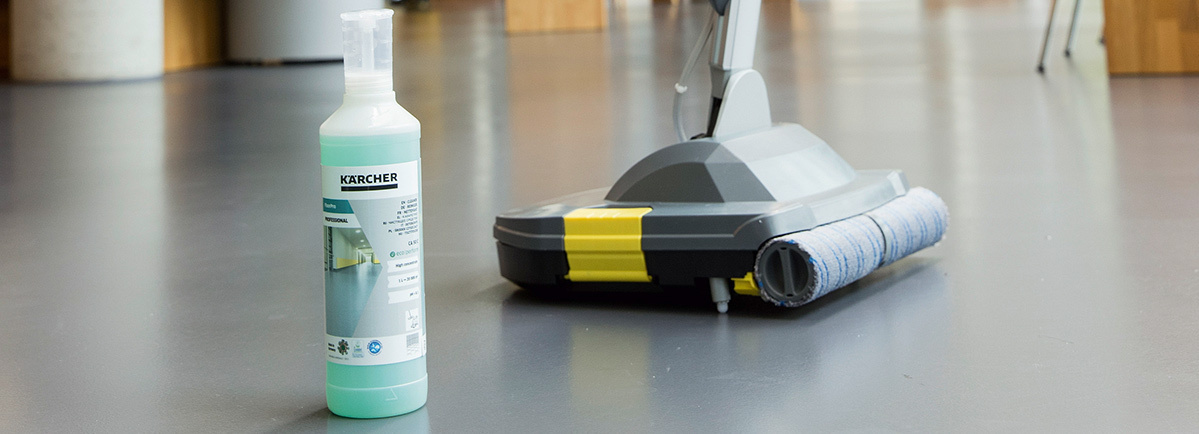
The ultra-lightweight BVL 5/1 BP backpack vacuum's low weight is due to the EPP plastic used in its production. However, the material is both extremely lightweight and fully recyclable. The vacuum also offers quiet, energy-efficient operation thanks to its brushless motor and eco!efficiency mode.
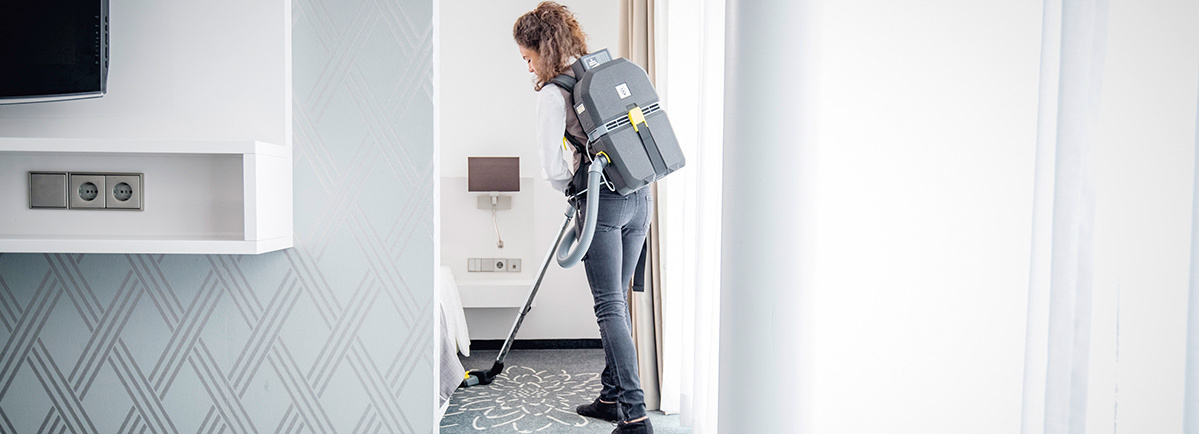
Kärcher was one of the first companies to use the "Technyl® 4earth® technology" from the manufacturer Domo in series production for the end consumer market. The recycled material used is extracted from fabric in recycled airbags and material left over from their production process. That guarantees both a consistent material quality and security of supply. In addition, CO₂ emissions, water consumption and the use of non-renewable energies can be significantly reduced.
The polyamide used is reinforced with 30 per cent fibreglass. As the spray lances of the Kärcher high-pressure cleaners must withstand an exceptionally high pressure during use and also have to be hard-wearing against environmental influences and cleaning agents. What is also special is that the recycled material displays no loss of properties compared with the raw material.

We use recycled material in our Home & Garden range whenever possible. For example, for the housings of our SC 3 steam cleaners, we use a specially developed polypropylene (PP) with a recycled content of 40 percent for the lower parts of the housings. This material does not show any losses compared to new plastic, so that the devices remain extremely robust.
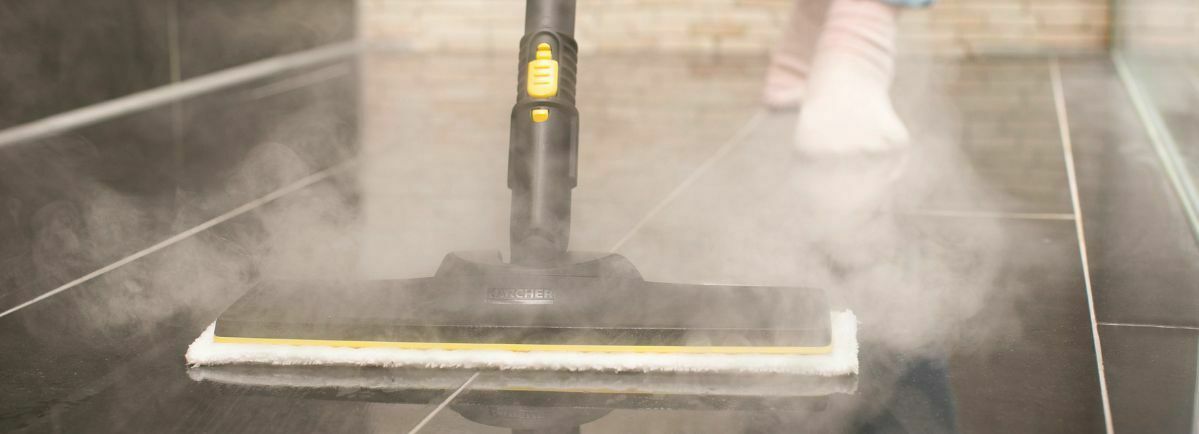
When it comes to materials, the Kärcher FlexoMate cleaning trolley line is fully committed to resource-saving product design. It is almost completely recyclable and can be combined with accessories, some of which are made from 100 percent recycled material. TThe material we buy for this occurs as waste during a manufacturing process. In foil extrusion, for example, the sides are cut off when machines start up if they are uneven or have colour changes. This waste is then shredded and returned to the market as granulate.
Sustainability is not only an aspect of the FlexoMate when it comes to the material: with adjustable handles and tiltable boxes, the cleaning trolley is very ergonomic and therefore sustainable for the user. And if it is integrated into Connected Cleaning environments, in which the frequency of use in rooms is recorded, cleaning work can be carried out as needed - which also saves resources and consumables.


Conscious use of cleaning agent
A cleaning agent does not always have to be used for a thorough cleaning. As plenty of dirt can be removed entirely without the use of chemicals, with steam cleaners or hot water high-pressure cleaners, for example. In many areas, however, use of an efficient and application-oriented cleaning agent is essential for the best possible result. Kärcher has been developing products that are good for the environment for more than 30 years. All are biodegradable, consequently reducing waste water pollution. In the development process, a whole range of aspects should be considered to produce a cleaning agent sustainable across the entire life cycle – from raw material selection up to packaging. Since 2012, all Kärcher cleaning agents have been certified with the Sustainable Cleaning Label. The label characterises products which were manufactured in companies that act in a sustainable manner. In addition, a number of the more than 600 different Kärcher cleaning agents fulfil the requirements of international, sustainable environmental certificates.
Hot water high pressure cleaners disinfect large areas such as walls and floors without using any chemical agents. The combination of a high pressure jet and 98-degree hot water guarantees thorough cleaning, reducing bacteria, viruses and fungi to a minimum, even in hard-to-reach places such as crevices or corners. This enables industrial kitchens, swimming pools and food production premises to meet hygiene standards using hot water without chemicals.
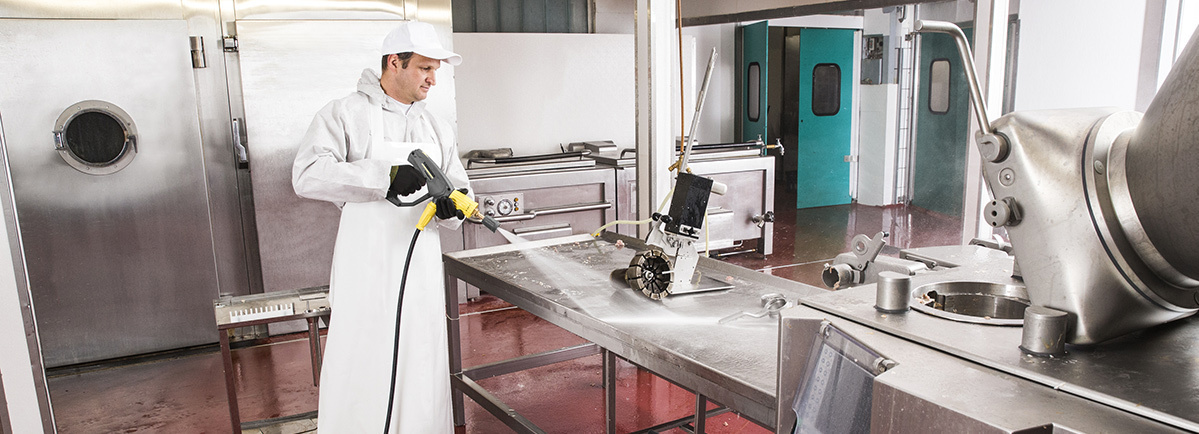
People often think it's better to put a little more cleaning agent in the tank at the beginning than having to go to more trouble to do it later on while you're cleaning. But thanks to the cleaning agent dosing system in the scrubber dryer, users no longer need to worry about this. The fresh water tank is automatically supplied with the preset amount of cleaning agent. This means it's impossible to waste resources by overdosing.
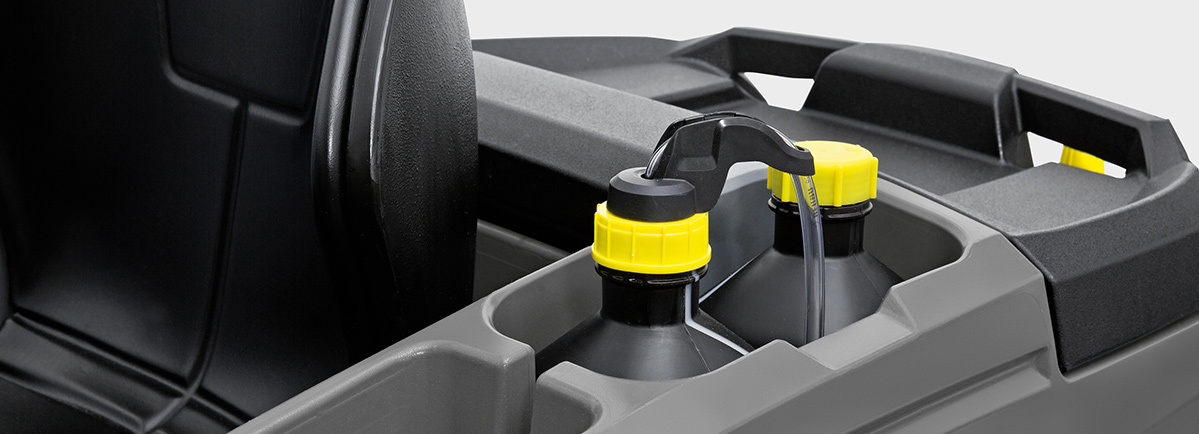
Under the name eco!perform, Kärcher offers environmentally friendly cleaning agents for professional use. The range includes a complete line for building cleaning and products for vehicle washes, which have been awarded international environmental certificates such as the EU Ecolabel or the Nordic Swan Ecolabel.
In order to satisfy the strict requirements, the eco!perform concentrates satisfy the issue of sustainability in a number of ways. Firstly, Kärcher totally dispenses with materials that endanger the environment and people's health during manufacture. So only fully degradable surfactants are used, and phosphates, microplastics and halogenated hydrocarbons that are hazardous to health are avoided. In addition, the fragrances and dyes used meet the standards of the international ecological certification. The containers also comply with the environmental requirements regarding weight, composition and recycling.
The eco!perform products are also particularly sustainable in terms of dosing. Small amounts of the agent are enough to achieve the best possible cleaning result. Owing to their high effectiveness they are very efficient, and up to 50 per cent less agent than comparable products can be measured out.

Destroy weeds on paths and open spaces totally without chemicals – the use of hot water allows this. This way, dandelions, thistles, etc. can be removed totally without herbicides. The principle of thermal weed control is based on a basic biochemical rule – most proteins denature from a temperature of about 42 °C. This means that the proteins change, break up and are no longer able to fulfil their functions.
The heat required for this can be generated and converted in different ways – as a direct flame or indirectly via thermal radiation, as hot water or steam. Of these, hot water is the only method without chemicals that also sustainably reaches the roots and consequently curbs fast regrowth. Hot water high-pressure cleaners can offer a consistent water temperature of up to 98 °C, which is just under the steam limit and is therefore ideal. Even if the roots are not immediately completely destroyed, the weed is further weakened with each application of hot water. If it is regularly applied right from the beginning, regrowth is impeded and the application frequency will significantly decrease as early as the second year. As a rule of thumb, three to four treatments a year are sufficient.

Floor coverings were polished using crystallisation for many years. This is often still true even today. The user applies an acid to the floor covering here, which they then work in mechanically in order to etch the surface. Then the floor is polished – a laborious procedure that produces a great deal of dust, and which on account of the acid is not without danger. Meanwhile, instead of this process, single-disc machines or scrubber driers are now operating with diamond abrasive pads, which can be used on nearly all stone surfaces and bring back the shine to high-gloss surfaces in a single work step.

Totally without chemicals, thanks to the preset steam flow control, the SC 2 Upright EasyFix steam mop is ideally suited to clean all sealed hard floors – even wood. With thorough cleaning, the machine actually eliminates up to 99.999 per cent of enveloped viruses*, such as coronavirus or influenza viruses, and 99.99 per cent of typical household bacteria**. When it comes to thorough cleaning, the SC 2 Upright EasyFix Premium is considerably superior to conventional methods such as using a mop, thanks to the combination of the EasyFix floor nozzle with the hook-and-loop system and high-quality microfibre cloths. So the user do not have to come into contact with dirt when changing the cloth.
*When spot cleaning using the Kärcher steam cleaner, i.e. a steaming duration of 30 seconds at the maximum steam stage with direct contact with the surface to be cleaned, 99.999 per cent of enveloped viruses such as coronaviruses and influenza viruses (except the hepatitis B virus) can be removed from typical smooth and hard household surfaces (test germs: Modified Vaccinia Ankara virus).
**When cleaning at a cleaning speed of 30 cm/s at the maximum steam stage and with direct contact with the surface to be cleaned, 99.99 per cent of all household bacteria on smooth, hard household surfaces are killed (test germs: Enterococcus hirae).
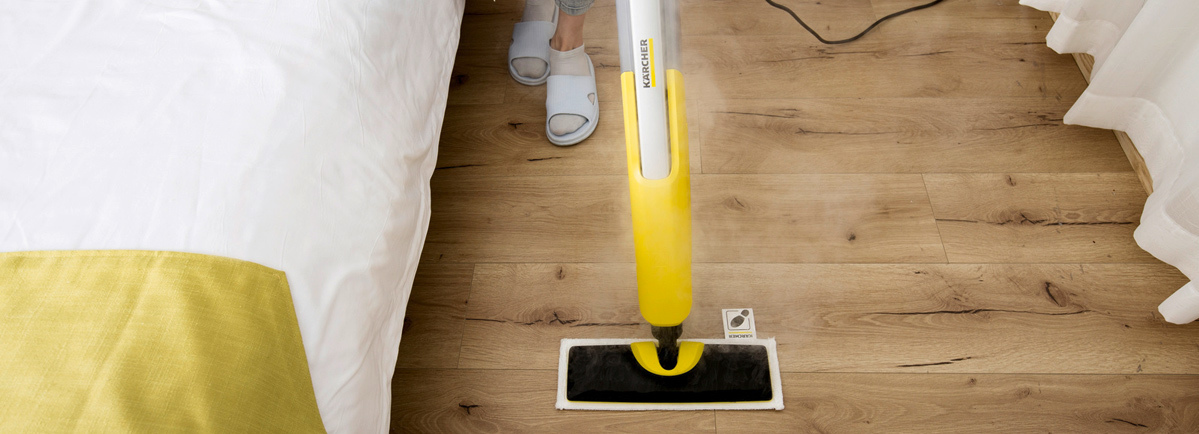
A mild cleaning agent for floor cleaning is not only good for the environment. In households with children or pets, for example, it also reduces the risk of irritation that can occur due to residues of strong cleaning chemicals. The natural floor cleaner RM 538N is suitable for all sealed hard floors such as wood, cork, tiles, stone, vinyl, PVC or linoleum. Its plant-based formula contains no dyes, synthetic fragrances, parabens, silicones or microplastics. More than 99 percent of the ingredients are renewable raw materials, and the tensides used are biodegradable. Last but not least, the bottle itself is 100 percent recyclable.

This might also interest you:




